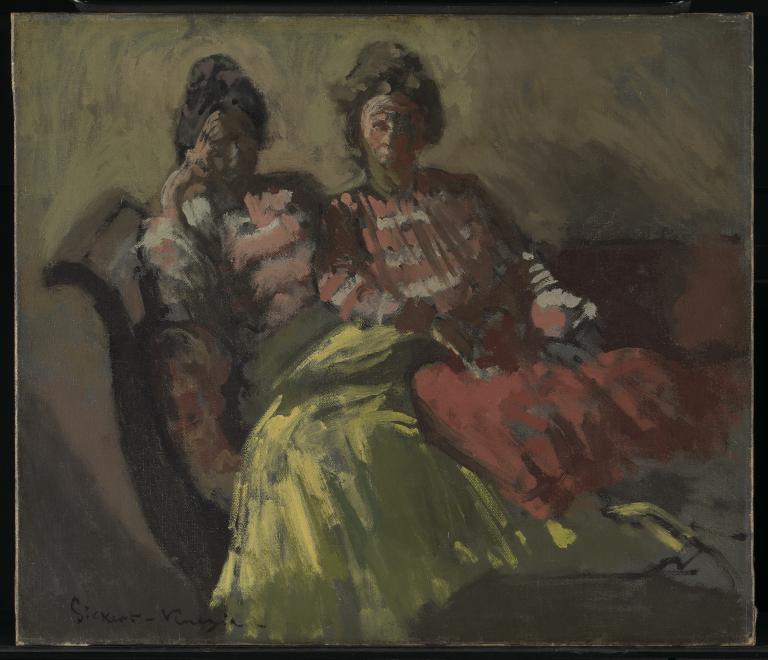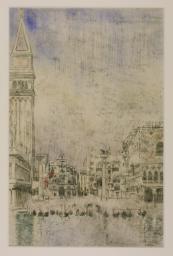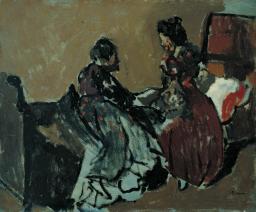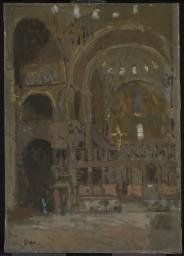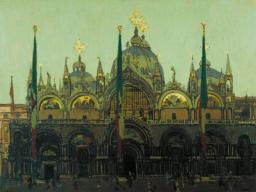Walter Richard Sickert Two Women on a Sofa - Le Tose c.1903-4
Walter Richard Sickert,
Two Women on a Sofa - Le Tose
c.1903-4
Sickert’s models, the prostitutes Carolina dell’Acqua and La Giuseppina, sit closely together on an Empire style sofa in his Venice studio. The painting’s planar composition focuses the viewer’s attention on the pair: wearing brightly coloured skirts, their facial expressions difficult to read. ‘Le Tose’ is Venetian slang for ‘the girls’, a casual expression supported by Sickert’s intimate picture.
Walter Richard Sickert 1860–1942
Two Women on a Sofa – Le Tose
c.1903–4
Oil paint on canvas
457 x 533 mm
Inscribed by the artist ‘Sickert – Venezia –’ bottom left
Bequeathed by Sir Hugh Walpole 1941
N05296
c.1903–4
Oil paint on canvas
457 x 533 mm
Inscribed by the artist ‘Sickert – Venezia –’ bottom left
Bequeathed by Sir Hugh Walpole 1941
N05296
Ownership history
... ; Sir Hugh Walpole (1884–1941) by 1933, by whom bequeathed to Tate Gallery 1941.
Exhibition history
1933
Retrospective Exhibition of Pictures by W.R. Sickert, A.R.A., Agnew’s, London, November–December 1933 (54, as ‘Le Tose’).
1935
61st Autumn Exhibition, Walker Art Gallery, Liverpool, October 1935–January 1936 (82).
1937
Hugh Walpole’s Collection, French Gallery, London, May–June 1937 (26, as ‘Conversation’).
1941
Sickert Exhibition, National Gallery, London, August–December 1941 (55).
1942
The Tate Gallery’s Wartime Acquisitions, National Gallery, London, April–May 1942 (122).
1942–3
A Selection from the Tate Gallery’s Wartime Acquisitions, (Council for the Encouragement of Music and the Arts tour), Royal Exchange, London, July–August 1942, Cheltenham Art Gallery, September 1942, Ashmolean Museum, Oxford, October 1942, Galleries of Birmingham Society of Arts, November–December 1942, Fitzwilliam Museum, Cambridge, January–February 1943, Victoria Art Gallery, Bath, February–March 1943, National Museum of Wales, Cardiff, March–April 1943, Manchester City Art Gallery, April–May 1943, Philharmonic Hall, Liverpool, May–June 1943, National Gallery of Scotland, Edinburgh, June 1943, Glasgow Museum and Art Gallery, Kelvingrove, July 1943, Laing Art Gallery, Newcastle upon Tyne, August 1943 (84).
1946–7
Modern British Pictures from the Tate Gallery, (British Council tour), Palais des Beaux-Arts, Brussels, January–February 1946 (86), Stedelijk Museum, Amsterdam, March 1946 (86), Raadhushallen, Copenhagen, April–May 1946 (86), Musée du Jeu de Paume, Paris, June–July 1946 (86), Musée des Beaux-Arts, Berne, August 1946 (89), Akademie der Bildenden Kunste, Vienna, September 1946 (90), Narodni Galerie, Prague, October–November 1946 (90), Muzeum Narodwe, Warsaw, November–December 1946 (90), Galleria d’Arte Moderna, Rome, January–February 1947 (90, reproduced 90), Tate Gallery, London, May–September 1947 (5296).
1947–8
Modern British Pictures from the Tate Gallery, (Arts Council tour), Leicester Museum and Art Gallery, September–October 1947, Graves Art Gallery, Sheffield, October–November 1947, Birmingham City Museum and Art Gallery, November–December 1947, Bristol City Art Gallery, January–February 1948, Russell-Cotes Art Gallery, Bournemouth, February–March 1948, Brighton Art Gallery and Museum, March–April 1948, Plymouth Art Gallery, April–May 1948, Castle Museum, Nottingham, May–June 1948, Huddersfield Museum and Art Gallery, June–July 1948, Aberdeen Art Gallery, July–August 1948, Salford Art Gallery and Museum, August–September 1948 (57).
1950
British Art: The Last Fifty Years 1900–1950, English Speaking Union tour of USA, opened New York, October 1950 (31).
1968
Fifth Adelaide Festival of Arts: Walter Sickert, Art Gallery of South Australia, Adelaide, 1968 (21).
1977–8
Sickert, (Arts Council tour), Ferens Art Gallery, Hull, December 1977–January 1978, Glasgow Art Gallery, February–March 1978, City Museum and Art Gallery, Plymouth, April–May 1978 (19, reproduced).
1983–4
Mito e immagine di Venezia nell’età romantica, Museo Correr, Venice, December 1983–March 1984.
1989–90
W.R. Sickert: Drawings and Paintings 1890–1942, Tate Gallery, Liverpool, March 1989–February 1990, Tate Gallery, London, July–September 1990 (28, reproduced).
2004
Walter Richard Sickert: The Human Canvas, Abbott Hall Art Gallery, Kendal, July–October 2004 (12, reproduced).
2005–6
Degas, Sickert and Toulouse Lautrec: London and Paris 1870–1910, Tate Britain, October 2005–January 2006 (105, reproduced).
2009
Sickert in Venice, Dulwich Picture Gallery, London, March–May 2009 (56, reproduced).
2010
The Art of Walter Sickert, The Lightbox, Woking, May–July 2010 (no catalogue).
References
1960
Lillian Browse, Sickert, London 1960, pp.71, 73, 101, reproduced pl.43.
1964
Mary Chamot, Dennis Farr and Martin Butlin, Tate Gallery Catalogues: The Modern British Paintings, Drawings and Sculpture, vol.2, London 1964, p.634.
1973
Wendy Baron, Sickert, London 1973, pp.80, 336, no.196.
1976
Denys Sutton, Walter Sickert: A Biography, London 1976, p.121.
1988
Richard Shone, Walter Sickert, Oxford 1988, p.32, reproduced pl.22.
1992
Wendy Baron and Richard Shone (eds.), Sickert: Paintings, exhibition catalogue, Royal Academy, London 1992, pp.104, 144, 302, reproduced fig.99.
2001
David Peters Corbett, Walter Sickert, London 2001, pp.20, 24–5, reproduced fig.12.
2006
Wendy Baron, Sickert: Paintings and Drawings, New Haven and London 2006, no.214, reproduced.
Technique and condition
Two Women on a Sofa – Le Tose was painted using similar materials and techniques to those Sickert employed for A Marengo (Tate N04621). The support is probably of Italian origin: it has the same distinctive stretcher with dove-tailed cross-section, open mortice and tenon joints to restrict movement of the corners and the cloth is the same medium-weight fine plain weave cotton with opaque lead and chalk off-white priming.
Sickert applied an opaque grey layer onto the commercial priming. He then painted in oil using the grey primer as a mid-tone, depicting strong shadows using black paint with contrasting lights applied more thickly in yellow, pink and flesh colours. This is an economic method allowing him to execute the work quickly and spontaneously with very little reworking or rubbing down. The paint was of medium viscosity when applied and retains some of the brushwork. It has become more transparent with age causing a darkening of tone in the thinner areas over a grey priming and increased contrast with the thicker paint. There is a thin coating of varnish, which does not appear to be contemporary with the painting, although it is not known whether this replaced an earlier original varnish.
Stephen Hackney
May 2004
How to cite
Stephen Hackney, 'Technique and Condition', May 2004, in Robert Upstone, ‘Two Women on a Sofa – Le Tose c.1903–4 by Walter Richard Sickert’, catalogue entry, May 2009, in Helena Bonett, Ysanne Holt, Jennifer Mundy (eds.), The Camden Town Group in Context, Tate Research Publication, May 2012, https://wwwEntry
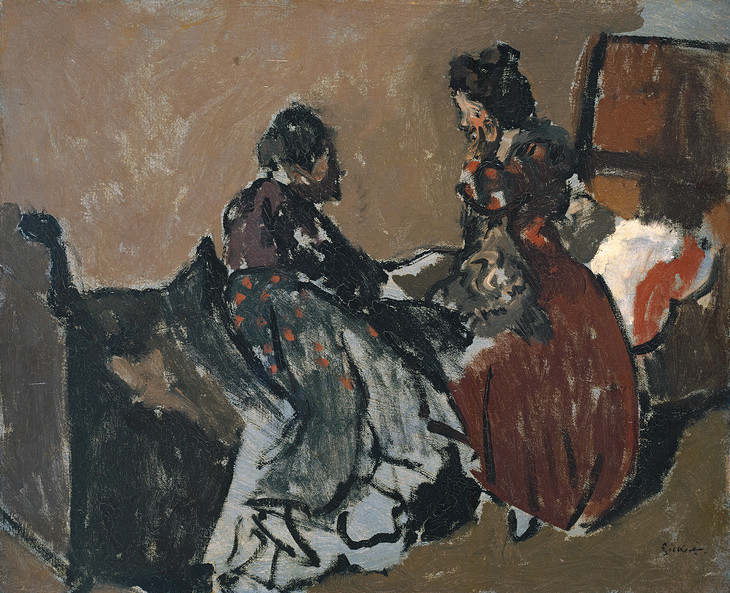
Walter Richard Sickert 1860–1942
A Marengo c.1903–4
Oil paint on canvas
support: 381 x 457 mm; frame: 527 x 610 x 92 mm
Tate N03621
Purchased 1922
© Tate
Fig.1
Walter Richard Sickert
A Marengo c.1903–4
Tate N03621
© Tate
As the art historian David Peters Corbett has noted, there are affinities with Edgar Degas’s pictures of resting prostitutes, such as Waiting c.1876–7 (Musée Picasso, Paris).1 However, whereas in pictures by Degas and Henri de Toulouse-Lautrec there is no question of the women’s occupation or the setting as a brothel, Sickert’s are less explicit,2 inviting the viewer to speculate on the significance of the scene. While this level of innocent reading is possible with Le Tose, it is more difficult to sustain in other pictures in the series, especially those such as Conversations 1903–4 (private collection)3 or Giuseppina and the Model 1903–4 (private collection),4 which combine a clothed figure with a naked one on a bed. Le Tose is the only picture in the series which shows the two women sitting together on a sofa.
In an account to his friend Jacques-Émile Blanche, Sickert stated that in this series of works he painted the figures directly, getting the models to hold their pose for an hour (see Tate N03621). However, he evidently also relied on drawings, as there is an upright pen and ink sketch of Le Tose’s left-hand figure inscribed ‘Sickert – Venezia’, which belonged to the Mayor Gallery in 1958.5 The art historian Wendy Baron also notes of Le Tose that ‘A spurious copy of this painting, known as The Two Sisters, has been in circulation’.6
By the time Sickert arrived in Venice, pictures of ‘la Serenissima’ were a popular and profitable component of the annual Royal Academy exhibition and the Paris Salon. Paintings of the city had, of course, been bought intermittently by British collectors since the time of Canaletto and Francesco Guardi, but a renewed enthusiasm peaked in the 1880s and 1890s. At this time large numbers of artists from many countries went to work in Venice to portray its picturesque canals and, most commonly, sentimental genre scenes of the inhabitants. The leading continental exponents of this type of picture were two Austrian painters, Cecil van Haanen (1844–1914) and Eugene von Blaas (1843–1932), whose style and choice of subject exerted a strong influence on the work of British painters such as Henry Woods (1846–1921). By 1886 the Art Journal was able to identify a ‘modern Venetian school’ whose foremost members were Woods, Luke Fildes (1844–1927) and William Logsdail (1859–1944), noting that:
Home-staying Englishmen, if they were years ago contented with such indistinct impressions of Venice as they received from Turner’s pictures or the stanzas in ‘Childe Harold’, are now familiar with another Venice, quite as poetic, quite as suggestive of romance, the Venice of today. Following the best of modern Art, which makes the real its aim and end, this clever Venetian school has carried us beyond Venice the romantic to Venice the actual, and has created our present interest in the delightful comedy of her streets and people ... yet they are not content merely to reproduce the noble beauty of her architecture or the lustrous hues of her landscape. They use these, yes; but as a background against which to set some scene of human interest, trivial at times, but always true.7
This popularity in London of anecdotal genre scenes from Venetian life adds an interesting background to Sickert’s decision to paint series of figures in interiors on his 1903–4 visit. Another context in which to see them, and which the genre scenes also engage with, is the interest in physical type, and specifically the different attributes of Venetian women. Various books appeared in the second half of the nineteenth century which adopted an ethnographic approach to the women of Venice. As the art historian Alastair Grieve has noted, there was interest in the possibility that the physical type which had once fascinated Titian was still to be found in the city.8 Published in London in 1894, the German critic Henry Perl’s book Venezia records and comments extensively on different female types, even down to their way of walking. Perl, who was in fact a woman writing under a male alias, drew comparison between ‘the rosy-fleshed Venus-like form rendered so familiar to us in the paintings of Giorgione and Titian’ with ‘the slender yet muscular brunette, who has hitherto been too much neglected’.9
A further context in which to view Sickert’s figure pictures is the widely held contemporary conviction that Venice was a place of moral degradation. As Grieve has noted, one of the leitmotifs of John Ruskin’s Stones of Venice (1851–3) was his belief that the fall of Venice’s power as a city state was an inevitable effect of the moral decay of its populace.10 In this scheme, the physical crumbling of Venice’s architectural heritage mirrored or expressed the moral collapse of the people.
The first recorded owner of Le Tose was Hugh Walpole (1884–1941), the writer of popular historical novels. He collected nineteenth- and twentieth-century art widely, and owned a number of Sickerts. In 1928 he wrote a preface for the catalogue of Sickert’s exhibition at the Savile Gallery, and its director R.E.A. Wilson commissioned Sickert to paint his portrait (1928, Fitzwilliam Museum, Cambridge).11 Giving an indication of the catholic nature of his collecting taste, among the works he bequeathed to the Tate Gallery in 1941 were Max Beerbohm’s Rossetti series (A01038–A01060), Philip Wilson Steer’s Nutting (N05290) and Girl in a Blue Dress (N05295), William Blake’s The Soul Hovering over the Body Reluctantly Parting with Life (N05300), James Tissot’s Portsmouth Dockyard (N05302), Auguste Renoir’s Head of a Girl (N05293), and Montagne Sainte Victoire by Paul Cézanne (N05303).
Robert Upstone
May 2009
Notes
Reproduced in Wendy Baron, Sickert: Paintings and Drawings, New Haven and London 2006, no.217 and Sickert: Paintings, exhibition catalogue, Royal Academy, London 1992 (41).
Related biographies
Related catalogue entries
How to cite
Robert Upstone, ‘Two Women on a Sofa – Le Tose c.1903–4 by Walter Richard Sickert’, catalogue entry, May 2009, in Helena Bonett, Ysanne Holt, Jennifer Mundy (eds.), The Camden Town Group in Context, Tate Research Publication, May 2012, https://www

